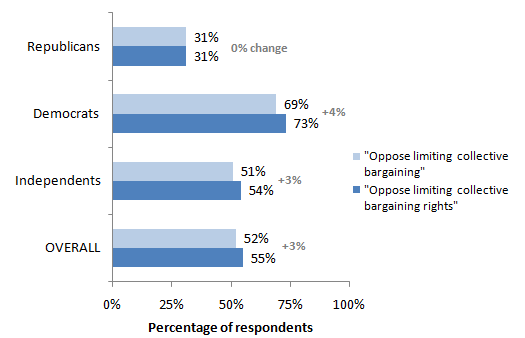Polling, communications strategy, and Ohio Senate Bill 5
Governmental entities, nonprofit agencies, or their private-sector communication partners often want to learn 1) the psychological “hot buttons” that may generate a desired response (e.g., “Give time/money!” “Vote yes on Issue X!”) and 2) the psychological “red flags” that may generate an undesired response.
We find this type of research fascinating and oddly exciting. However, confidentiality agreements limit our ability to talk about most of the work we’ve conducted in this capacity.
Just last week, however, we became aware of survey results from the independent Quinnipiac University Polling Institute regarding a highly contentious issue in Ohio: Senate Bill 5. These results have the potential to guide communications strategy, and because we are a neutral party to the issue*, we are able to comment on it.
For those who may be unaware, Senate Bill 5 calls for major changes to Ohio’s labor laws. As may be expected, the passage and eventual signing of Senate Bill 5 led to a strong outcry from those who are most likely to be negatively affected by the legislation, including state and municipal employees and teachers. Over the past few months, hundreds of thousands of Ohioans have signed a petition with the intent to repeal this law, with a major political fight brewing for November 2011.
In Quinnipiac’s poll of registered voters, we noticed there were two questions asked of respondents that demonstrates how research has the potential to affect communications strategy.
Half of the 1,600+ respondents were randomly selected to hear the following question:
As you may know, there is a new law in Ohio that would limit collective bargaining for public employees. Do you support or oppose limiting collective bargaining for public employees?
The other half of the respondents were asked a slight variation of the same question:
As you may know, there is a new law in Ohio that would limit collective bargaining rights for public employees. Do you support or oppose limiting collective bargaining rights for public employees? (emphasis added)
How much difference can one word make? As shown in the chart below, including the word “rights” leads to changes in the percent of individuals who say they oppose this law – changes that approach statistical significance (meaning the difference is unlikely to have been caused by chance alone). This effect is strongest among registered Democrats, most of whom report a desire to oppose the legislation.
Although this pattern is small, it shows how quality research has the potential to influence communications strategy. In other words, if these polling patterns remain stable or become stronger through the rest of the summer, I would expect those groups that oppose Senate Bill 5 (and who favor its repeal) to position the repeal issue in terms of worker rights that are threatened. Time will tell.
* The Strategy Team, Ltd. has not been retained by individuals or groups on either side of this issue. Like the majority of Ohioans, we’re interested observers.
